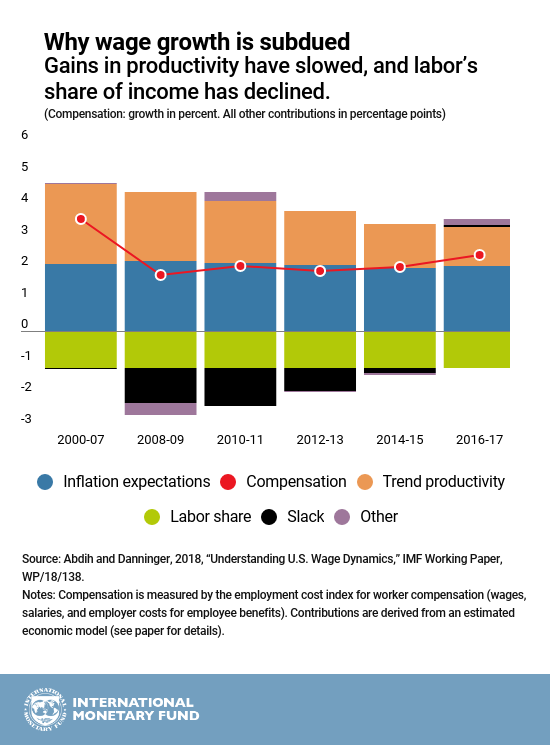July 10, 2018
[caption id="attachment_23986" align="alignnone" width="1024"] Hiring is strong, but workers still aren’t seeing big raises (photo: Kutay Tanir/Getty Images by iStock).[/caption]
Hiring is strong, but workers still aren’t seeing big raises (photo: Kutay Tanir/Getty Images by iStock).[/caption]
Wages in the US have grown slowly in recent years, even as the unemployment rate has fallen to the lowest levels in decades. This is puzzling. Economic theory and common sense suggest that companies competing for a shrinking pool of available workers would have to raise wages as the labor market tightens.
What explains stagnant wage growth, then? The Chart of the Week, based on our new study, offers a plausible answer: slower growth in labor productivity—the amount of goods or services produced in an hour of work—and a decline in the share of income that goes to workers. Both have held wages down, overcoming the positive impact of a declining unemployment rate.
The chart shows that worker compensation (the red line) has increased just 2 percent or so each year, on average, since the Great Recession, down from 3½ percent in the eight years before. That’s barely keeping up with expected inflation—the blue bars—even though unemployment, or “slack,” has diminished, as indicated by the black bars.
How productive workers are is a key factor for employers when making compensation decisions.
A key explanation lies in slower labor productivity growth, as depicted by the orange bars. How productive workers are is a key factor for employers when making compensation decisions. If workers aren’t producing as much, employers need to restrain pay growth to sustain profitability.
Another factor that has held down wage growth is a falling share of income that is paid to workers (the green bars). In an earlier study, we examined the reasons behind this decline and found that the bulk of the effect came from changes in technology that are linked to the automation of routine tasks, followed by import penetration.
The role of slowing productivity growth underscores the importance of policies to encourage investment and innovation while facilitating the movement of capital and labor toward their most productive uses.
Policies also need to foster systems for continuous retooling and upgrading of worker skills. Although education and training programs would not immediately address the short-term adjustment costs for affected workers, over time they could enhance the resilience of employment and productivity of labor. Investing in education and training programs outside traditional channels could prepare future workers to keep up with technological progress and global competition.







